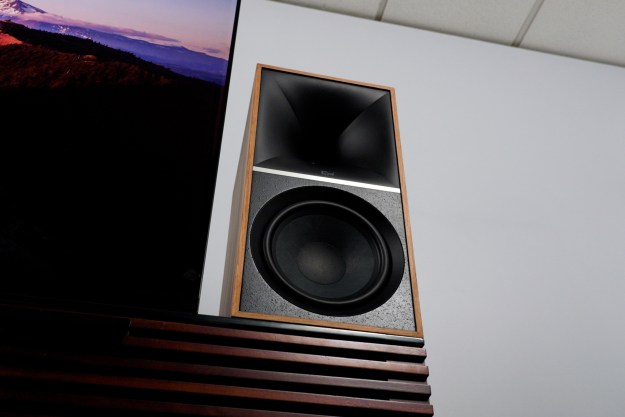
“Good luck finding a more exhilarating audio experience in one box than what you get with Klipsch The Nines.”
- Exhilarating sound
- Powerful, moving bass
- Comprehensive inputs
- Wide and deep soundstage
- Gorgeous finish
- Large footprint
- No built-in Wi-Fi
What happens when Klipsch dresses powered speakers to The Nines? When you get over that terrible pun, please read on to find out.
Jokes aside, The Nines are Klipsch’s most ambitious powered speakers yet — and they really are remarkable. Technically speaking, they are the biggest sibling in a growing family of powered speakers that includes The Fives, The Sixes, and The Sevens (which we also reviewed). But don’t dismiss The Nines as simply falling into line with the all-too-common “bigger is better” axiom that too often plagues the world of audio/video. The Nines are special in their own right.
But, yeah. They’re also big.
Size
Two things I must address right off the bat. First, the Nines are large and, as it turns out, very much in charge. But we’ll get to that. Back to the size. Despite the efforts to give you some sense of scale on its website, Klipsch’s photos of The Nines — and their slightly smaller siblings, The Sevens — don’t really capture their … bigness. At least not relative to most powered speakers. These are nowhere close to the size of a standard bookshelf speaker, not that Klipsch is trying to pass them off as such.
To help put The Nines’ size in context, see one of them pictured below, to the right of an SVS Prime Wireless Pro speaker, and an Elac UB5. The two on the left are bookshelf speakers. The one on the right might best be called a “monitor.” If you prefer numbers, we’re talking 19.13 x 9.5 x 13.38 inches, and the speakers weigh 28.4 and 27 pounds each.
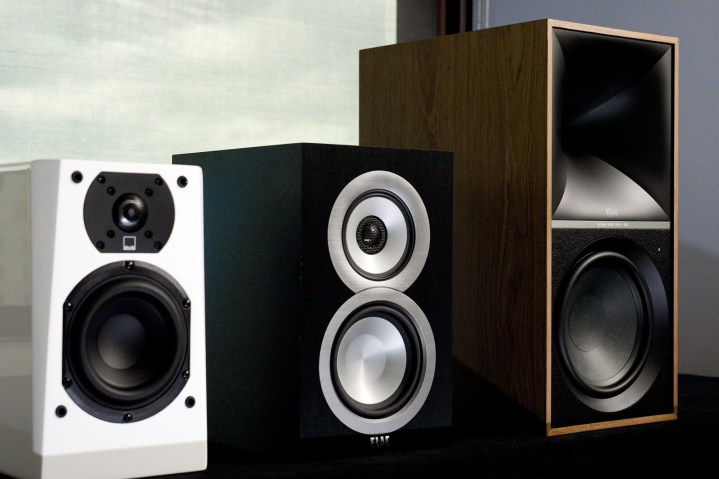
I personally have zero problems with the size, but you should know what you are getting into if you’re looking to purchase The Nines. And if you do pick up The Nines, I highly recommend getting the speaker stands that Klipsch offers to go with them, or a suitable set of stands elsewhere, because while The Nines aren’t super picky about placement, there definitely is a right way to set them up, which I’ll get to in a moment.
Powered, not smart
The second thing I want to get into is that The Nines are not a “smart speaker.” There’s no built-in Wi-Fi, no built-in Alexa, Siri, or Google Assistant. I’ll stop short of calling them “dumb” speakers because there is a handy companion app, but The Nines — just like The Fives that came out in 2020 — aren’t trying to be anything remotely like a HomePod, Echo, or Nest speaker. So … what are they?
The Nines aren’t really replacing a modern receiver and speakers.
Well, they are a bigger, badder version of Klipsch’s The Fives, which I’ll remind you were the first powered speakers to include an HDMI ARC connection. Lots of others have now jumped on that bandwagon, but The Fives did it first and we thank them for creating the category.
In fact, we called The Fives the best soundbar alternative for music lovers. Klipsch calls them the best alternative to a receiver and stereo speakers. And I’ll concede that to a point, but these days, most people expect their receiver to have built-in Wi-Fi, Spotify Connect, AirPlay, etc. The Fives, Sevens, and Nines don’t have that, so they aren’t really replacing a modern receiver and speakers. Rather, they function more like a replacement for the classic, midcentury awesomeness of a vintage receiver and speakers.
Connections and controls
This leads us nicely into how you connect and interact with The Nines. They have every input you need and want. There’s an HDMI ARC connection so you can get all your TV audio out through the speakers, there’s a USB input (which even the KEF LS Wireless line doesn’t support anymore), optical digital if your TV doesn’t have HDMI ARC, and then my personal favorite, a phono input (switchable to use a built-in phono preamp or line-in) with a ground plug to connect your favorite turntable. Moving magnet cartridges only need apply — if you have a fancier moving coil cartridge, you’ll need to supply your own phono preamp.
There’s also a subwoofer output, although as I’ll discuss soon, The Nines take care of bass business just fine on their own.
As for control, Klipsch offers an input selector dial and a volume dial on the top of the speaker, and they are a treat to use. The response of the knurled metal dials feels awesome and pairs nicely with the tactile experience of handling and playing back vinyl on a turntable, which I did a lot during my testing.
You also get a remote with input selectors, volume control, sub control, and a play/pause button. And then there’s the Klipsch app, which is a little rudimentary, but gets the job done. The app is where you can pick some sound profiles or create and save your own. I should also point out that the app communicates with the speakers via Bluetooth, so you’ll want to be within range to use it. I also wish the app connected more quickly, but it is what it is.
Build quality
As for build quality and internal components, The Nines are exactly as you’d expect if you’re familiar with the Kllipsch Brand. The cabinets are well-built — they pass the knuckle test — and covered with a gorgeous real wood veneer. I like the magnetic grills that came with this pair — just one of several elements that give me strong Forte Four vibes — though to be honest, I leave them off. The only aesthetic annoyance is a little brag line on the speaker. I wish it wasn’t there, but I’ll live with it.
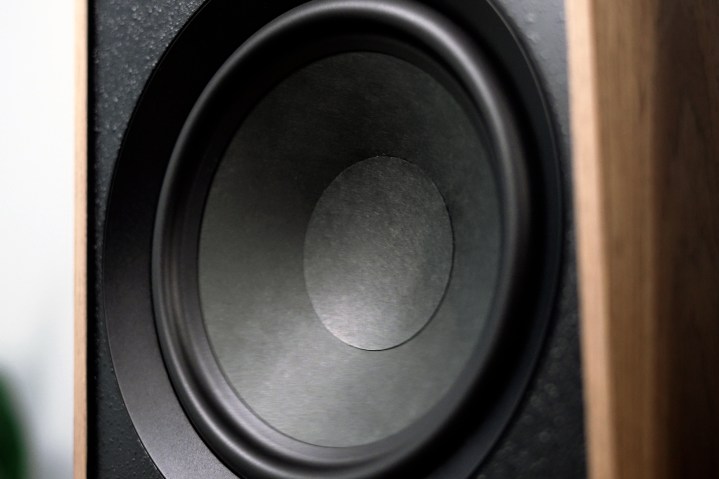
On the bottom, there’s a super-robust 8-inch midwoofer mated to a 1-inch Titanium dome tweeter set in Klipsch’s proprietary Tractrix horn enclosure. As for amplification, The Nines offer 240 watts total power and can peak at up to 480 watts. Klipsch tells me the internal amplifiers deliver 100 watts each to the midwoofers and 30 watts each to the tweeters — double those figures for peak power output — which is more than enough to drive such an efficient speaker design.
Setup
Setting up The Nines is a piece of cake. Everything you need to connect them is in the box, and that includes an HDMI cable, as well as an already lengthy speaker cable, along with an extension for that speaker cable. Klipsch even provides a USB cable. If you’re going to use optical digital, you’ll need to provide that yourself, and if you connect a subwoofer, that cable is also on you.
Having stands for them is going to be the best choice for a lot of folks.
Speaking of the sub out, Klipsch tells me the crossover for the sub and speakers is set at 60Hz when a subwoofer cable is plugged in, so you don’t get to run The Nines at their full range and then dial in the sub just to handle the lowest octave. But Klipsch takes the reins for a reason, handling the blend between speakers and sub on its own, which it had to do since Klipsch also folds in a dynamic bass feature that I’ll dig into in a moment.
As for placement, the speakers are pretty versatile in terms of how far apart from each other they can be placed, and you even have some wiggle room for their height. My BDI cabinet places the bottom of the speakers 28 inches off the floor, but a speaker stand between 24 and 30 inches is probably fine. But you really, really need to pull these speakers about 18 inches from the wall — a foot at the very least — to get the best bass response, soundstage, and imaging in most rooms. That’s why I think having stands for them is going to be the best choice for a lot of folks.
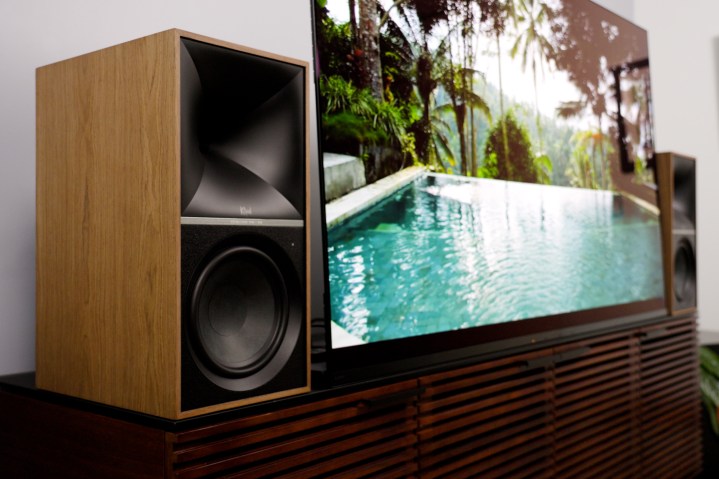
One last setup touch that I love is that the main speaker with all the connections and controls can be placed as the left speaker or the right, thanks to a switch on the back. This versatility was essential for me since the HDMI ports on the Sony A95K OLED I tested the speakers with are on the left, as was my turntable.
How I tested
We’re about to get into sound quality, but first a quick word on how I tested The Nines. I played vinyl using an EAT B-Sharp turntable connected both to The Nines’ own phono-preamp input and to an outboard phono preamp from Cambridge Audio. I also connected a laptop via USB, and I used the Sony A95K as a source for both movies and music streaming as well. I tested the Bluetooth audio connection for posterity but rarely used it. Instead, or when streaming music, I used a Wiim Pro streamer, though the Wiim Mini would have done the job just as well.
One last note: The Nines only accept PCM digital audio, so be sure to set your TV to output PCM, and if you want to listen to high-res music, you’ll need to convert it to PCM before you output to the speakers. They don’t decode FLAC, MQA, etc.
I think all that stuff was important to talk about, but let’s get to the goods, shall we? How do they sound?
Sound quality
It’s simple. They sound awesome. I’ve enjoyed these speakers so, so much. I haven’t had this much fun since we had the Forte IV in here. They have that Klipsch Heritage speaker vibe nailed. Now, mine definitely benefited from a little break-in (I know there are speaker break-in deniers out there, and that’s fine. All I’m saying is that the treble had just a touch more bite than I wanted with the speakers straight out of the box). I ran some burn-in noise on them for about 15 hours, and that’s all it took. I came back to them and listened to the same tracks, and the treble was noticeably smoother. My ears didn’t relax into them — the sound profile changed. Do I have measurements to back that up? Nope, I’m sorry, I don’t, but I would urge you to see for yourself.
There’s not much I don’t love about listening to these speakers. They are a riot of fun. Can they get loud? They’re Klipsch — yes, they get loud. And they do it without distortion. Can they get loud without being fatiguing? For me, yes. More sensitive listeners might find the highs have a bit more sparkle than is to their taste. These speakers don’t have silk dome tweeter characteristics, but that doesn’t mean the treble isn’t sweet. It is … a little. But even more, they are incredibly articulate. The transients just leap out from the speakers. Every drummer’s brush stroke, every click of a drumstick on a cymbal, every brass overtone, every guitar pick — it’s all resolved with a remarkably precise attack, and the decay is quite natural as well. The resolution of detail is just such a treat.
But as delicate as they can be in the treble and midrange, they also grind hard. I used Dire Straits’ Love Over Gold on vinyl, which is rich with dynamics and rife with guitar distortion, punchy bass guitar, and thumping kick drum. The Nines brought Telegraph Road to life in a way I’ve not heard in some time.
There’s not much I don’t love about listening to these speakers.
I felt the same way listening to Fleetwood Mac’s Rumors record, particularly the song The Chain, which has steely guitar and thumping kick drum at the intro, followed by transcendent, borderline angelic vocals that were mic’d and mixed so they can leap out of the speakers and into the room when played through the right speakers. It’s definitely one of my go-to tracks, and definitely a track that has historically sounded great through Klipsch speakers, and The Nines, once again, delivered that Heritage Series sound I was looking for.
I do have to mention, though, that The Nines phono preamp is … fine. It’s decent. But if vinyl listening is going to be a big part of how you use The Nines, an outboard phono preamp will be a nice upgrade. Even something inexpensive like the Schiit Mani or Mani 2 would be a step up. Or a $350 Cambridge Duo sounds fantastic as well — plus it’s got a great headphone amp in it.
For hip-hop and R&B, The Nines brought deep, resonant, tuneful bass with plenty of punch. I never wanted a subwoofer for music listening. It just wasn’t necessary. I didn’t really need Klipsch’s Dynamic Bass feature either, which is meant to keep the bass at a satisfying level, even at lower volumes. For me, it just wasn’t necessary, but if you want to feel that lower octave at all volume levels, the dynamic bass feature will do that.
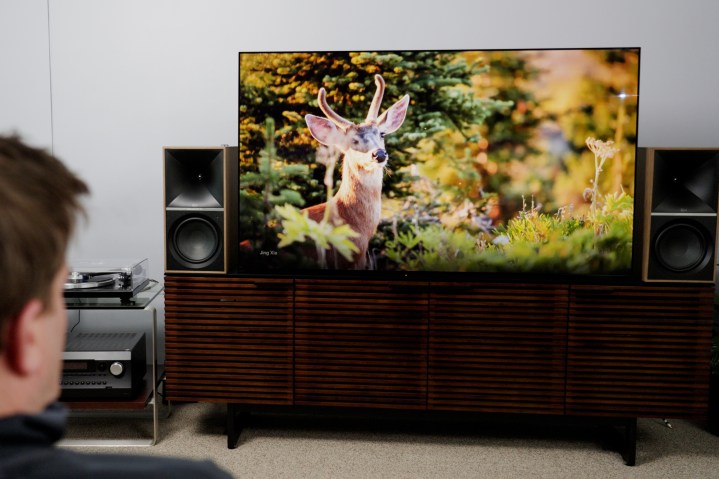
The only time a subwoofer was ever really a bonus was when watching movies. If you really want to feel your seat shake, then a sub can help deliver a bit more of that ultra-low, visceral, butt-shaking bass. And I’m sure Klipsch will be happy to sell you a sub — maybe one from its brand-new Reference line. But, honestly, I’d try The Nines without a sub first. You may well find you don’t want a sub. They just sound so powerful and rich on their own.
Final thoughts
The Nines simply are one of the best one-box audio solutions on the market, period.
Perhaps the greatest endorsement I can give The Nines is that I’m actually enjoying them just a bit more than a full-size set of Reference Premiere tower speakers mated to a massive Marantz SR8015 A/V receiver. The Nines are easier to set up, easier to place, and easier to enjoy. And they sound excellent. They are just a ton of fun, but they also retain an air of refinement that I don’t think a lot of people are going to expect.
So, at roughly $1,500, are The Nines worth it? I’d say yes, absolutely. Getting this kind of sound from a separate pair of speakers and an AVR is not only going to require more hassle and setup effort, but just as much, if not more, money. And honestly, the resulting sound of separates isn’t likely to exceed, or even match, what The Nines can do on their own.
The Nines are simply one of the best one-box audio solutions on the market, period. I’m going to enjoy listening to these for years.
Editors’ Recommendations
Services Marketplace – Listings, Bookings & Reviews
